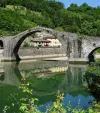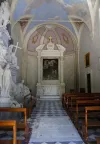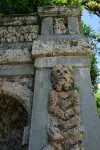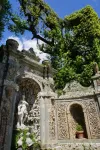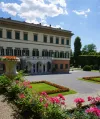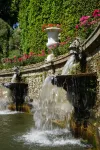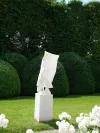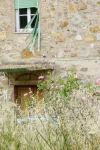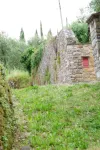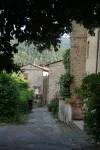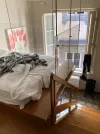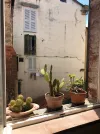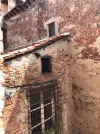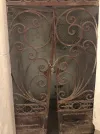Villa, village and Via del Moro
- 18 June 2020
- Prue Scott
We are roaring back into life in Lucca. We have tourists (Italian), spring thunderstorms and questionable social distancing down Via Fillungo.
How did you know they were Italian tourists, asked a friend. Aside from hearing them speak Italian, they were in full walking gear and taking photos of each other in front of a building. Locals don’t do that. We’re being told to expect lots of Germans.
Some great spring thunderstorms and I’ve twice biked home late-ish at night, somewhat intoxicated, during a break in the weather. I find these rides go very quickly – wonder why? Lightning, torrential rain, trees lose their branches (no resilience here) and leaves carpet the ground.
I appropriated a Kathmandu rain poncho at the previous apartment. Sadly, rather than chic Italian I look like a large pale whale on a bike and the plastic does nothing for my discomfort in the humidity. However, I arrive home only partly soaked.
A trip to the countryside with Bill and Patricia (BAP, for short). Seems the car rules are people from the same household (that’s BAP and Roberto the schnoodle) only. I sat with Roberto and pretended I wasn’t there.
First stop, the Ponte della Maddalena/Devil’s Bridge at Borgo a Mozzano. The bridge attracts as many people as the infamous Lake Wanaka tree or a Trafalgar Square pigeon nicking your fries.
Legend has it that the builder, Saint Julian, couldn’t complete the task and asked the Devil for help. In return, St J would offer him the soul of the first living being who crossed the finished bridge. Thus, St J threw a piece of bread onto the bridge, luring a dog to cross it, cheating the Devil. In response, the Devil is said to have punched the bridge up into its rounded shape, making it more difficult for anyone to use it. If truth be told, I suspect a committee came up with the design and the Devil gave up.
From there, it was into the hills above Lucca where one can find innumerable quaint villages and some excellent views.
Lunch was under a pergola at a roadside restaurant, tables well apart, and no menu. Printed menus are thought to be a Covid risk, so the waiter gives you a verbal menu. Patricia and I both wondered why they didn’t use a blackboard, or a large menu pinned to a convenient wall.
Never mind, we had a nice lunch and motored on towards Villa Reale, also known as Villa Marlia or Villa Reale di Marlia, just to confuse you. This late-renaissance palazzo or villa (again, just to confuse you) comes with exquisite gardens, follies, a lake and…..no one else there. We had the whole place to ourselves. Could Roberto come in? Of course, said the woman at the desk, we like dogs. Very sensible people, the Italians.
This is a small lesson in Italian history. Buonvisi family 1517-1651. Palazzina dell’Orologio with clock tower added in the 17th century. Gardens including the Teatro d'Acqua with fountains, statues, prominent pebble mosaic, and tufa exhedra axis terminus (don’t you just love the technical description?). Enter the Buonapartes. In 1806, Napoleon’s sister purchased the entire complex and the estate next door, as you do. She lost out to the Bourbons when her brother was caught being naughty. In the 1920s, Count Pecci-Blunt acquired and restored the property, and in 2015 it was sold to a young Swiss couple who are again renovating the buildings and grounds.
Contrast that with tiny Sant Andrea di Compito in the hills above Lucca. The town dates to the 13th century, and according to Wikipedia’s map legend, it has no inhabitants. Actually, we saw quite a few, particularly at the local stream where you can fill water bottles; the little town is famous for its streams of pure mountain water. Oh, and camellias which were past flowering. By the time we left, cars lined both sides of the narrow road to the spring; clearly, Sunday afternoon is when you refill your water bottles and flagons. There is much stone by the way of houses and walls, many winding and narrow roads, cobbled lanes and a stone tower complete with beacon fitting for signalling.
I’ve moved to a new part of town – Via del Moro. This is a second-floor studio with bed and bathroom on a mezzanine. Originally the home of a rich merchant, it is now home to a law firm and several apartments. Quite liveable in terms of space; everything works and I’m two small blocks from the centre of town.
Of course, this proximity has its disadvantages. First night here, I thought there were people in my living room. Via del M is short and narrow and where I am, it’s five storeys high. A natural amphitheatre if one has the large window open, which I do. I hear conversations between couples and families, and phone calls. Oh, and an Australian couple (the accent gave them away).
Her: How could you do that? I don’t believe you did that. How could you do that?
Him: (some unidentifiable sound)
I’ve no idea what wrong he had committed.
Proximity to shops and restaurants also means…..rubbish collection. Starting around 6am, we have trucks collecting rubbish from the neighbourhood bins behind my building. I swear they throw the glass into the collection truck. Then we have the other trucks that clear away all the boxes from the little Carrefour supermarket 15metres down the street. Then the street bins. Then the restaurant rubbish – more glass. Finishing with the street cleaning machines. In short, one doesn’t need an alarm of any kind.
I’ll end with food, simply because it’s so good. Off to Cibus with BAP and their friend Mark. This is your typical neighbourhood pizzeria; small, tables out on the street. Frederika the waitress offers a menu and we share a cestino. The menu describes this as a “raw basket with burrata cheese [stracchino], chives and Taggiasca olives, and fried pasta.” So, the four of us share a large dollop of cheese and its accompaniments, encircled by prosciutto with long fingers of fried pasta dough. Take note of that last item – fried pasta dough. Crisp on the outside, soft and chewy on the inside and heavily salted. It is gustatory heaven.
We’d had aperitivi prior so really didn’t need the cestino. We then ordered a pizza each, as thin as a thin plate, as large as a large plate, piping hot and very good. The men downed a bottle of red each and Patricia and I shared a bottle of rosé. Again, we’d been drinking at aperitivi, but what the heck. We’re not driving. The men declined dolce (desert) and Patricia and I shared a lemon semi-freddo. We all finished with limoncello (it aids the digestion).
I sped off into the dark on my bike, sailing over the cobbles (ouch, ouch, oof, uffa, ouch) and thinking how lucky I was to be in Italy.

